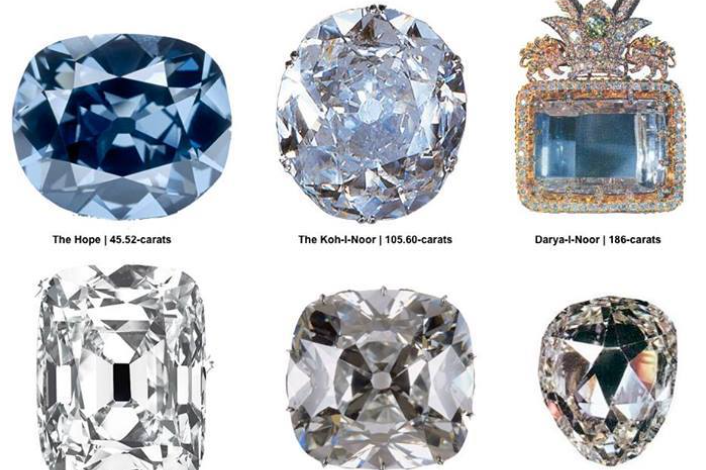Not Just The Koh-I-Noor, But Also Eight Priceless Golconda Diamonds That India LostHope Diamond

This purple blue diamond, which is believed to have originated from the Kolluru mines in Golconda, belonged to French merchant traveler Jean Baptiste Tavernier in the 1660s. Uncertainty surrounds the merchant’s acquisition of the diamond, but the Smithsonian claims that Tavernier bought the 112 3/16-carat stone and then sold it to King Louis XIV of France. On November 10, 1958, after passing through many hands, the French Blue was ultimately given to the Smithsonian Institution in Washington, DC. Only four times since then, for exhibitions, has the now 45.5-carat diamond been taken out of the museum.
Daria-i-Noor
The diamond Daria-i-Noor, which is frequently referred to as Kohinoor’s sister, is also thought to have its origins in the Golconda mines before being purchased by a series of Maratha kings and Shahs of Persia. After being purchased by Maharaja Ranjit Singh, Daria-i-Noor (Ocean of light) was later taken over by the East India Company, just like the Kohinoor. According to retired geology professor V. Madhavan of Kakatiya University, the 182-carat diamond is currently believed to be a piece of the Iranian crown jewels.
Noor-ul-Ain
One of the biggest pink diamonds in the world is rumored to have been transported from the Golconda mines with Daria-i-Noor. Like the former, the 60-carat diamond is now a piece of Iranian royal jewels.
Hortensia diamond
The 20-carat pentagonal diamond, whose origins are believed to have been in the Golconda mines, was reportedly purchased by King Louis XIV of France between 1643 and 1715. It is currently a piece of the French royal jewels. It is claimed that the diamond was taken twice—once during the French Revolution and again from the Ministry of Marine. The diamond is currently on display at the Galerie d’Apollon at the Louvre in Paris.
Regent diamond
Thomas Pitt, the English Governor of Madras, was interested in the stone when it was found in the Golconda mines in 1698, according to the Louvre. Regent Philippe d’Orléans then bought it in 1717 for the French throne since it was renowned for having the finest cut. The diamond, which once weighed 426 carats but has since been cut down to 140.6 carats, is now on display alongside the Hortensia diamond at the Louvre museum in Paris. Regent is one of the best diamonds ever found and is described as having the color of the first water, which is a flawless white.
Sancy diamond
The 55.232-carat Sancy diamond, part of the Paris crown jewels on display at the Louvre museum in Paris, is thought to be the sibling diamond of Regent and Hortensia. The diamond, which is also said to have originated from the Golconda mines, is claimed to have passed through the hands of several Indian emperors before falling into the hands of the French soldier Seigneur de Sancy between 1546 and 1629.
Shah diamond
The diamond, which dates to 1591, is believed to have been extracted from Golconda and was in the Shah court’s hands in Ahmednagar by the end of the 16th century. The diamond passed through the hands of the rulers Shah Jahaan and Jehangir before being taken by Nadir Shah of Iran. Along with the Orlov diamond, the diamond is currently a part of the Kremlin Diamond Fund’s collection. Professor V. Madhavan estimates the diamond’s weight to be 88.7 carats.
Orlov diamond
The 189.6-carat diamond is said to have come from the Golconda mines in Andhra Pradesh and to have the appearance of a half-egg. The origins of the Indian rose cut, which is linked to two stories, are yet unknown. A Frenchman allegedly stole the priceless stone from the Srirangam temple in Tamil Nadu and fled before selling it to the captain of an English ship. The Orlov diamond, according to one version, was formerly a component of that temple. However, according to the second version of the history, Orlov was ruled by Mughal monarchs before being eventually taken over by Iranian tyrant Nadir Shah. The Kremlin Diamond Fund presently owns it.
News Mania Desk






